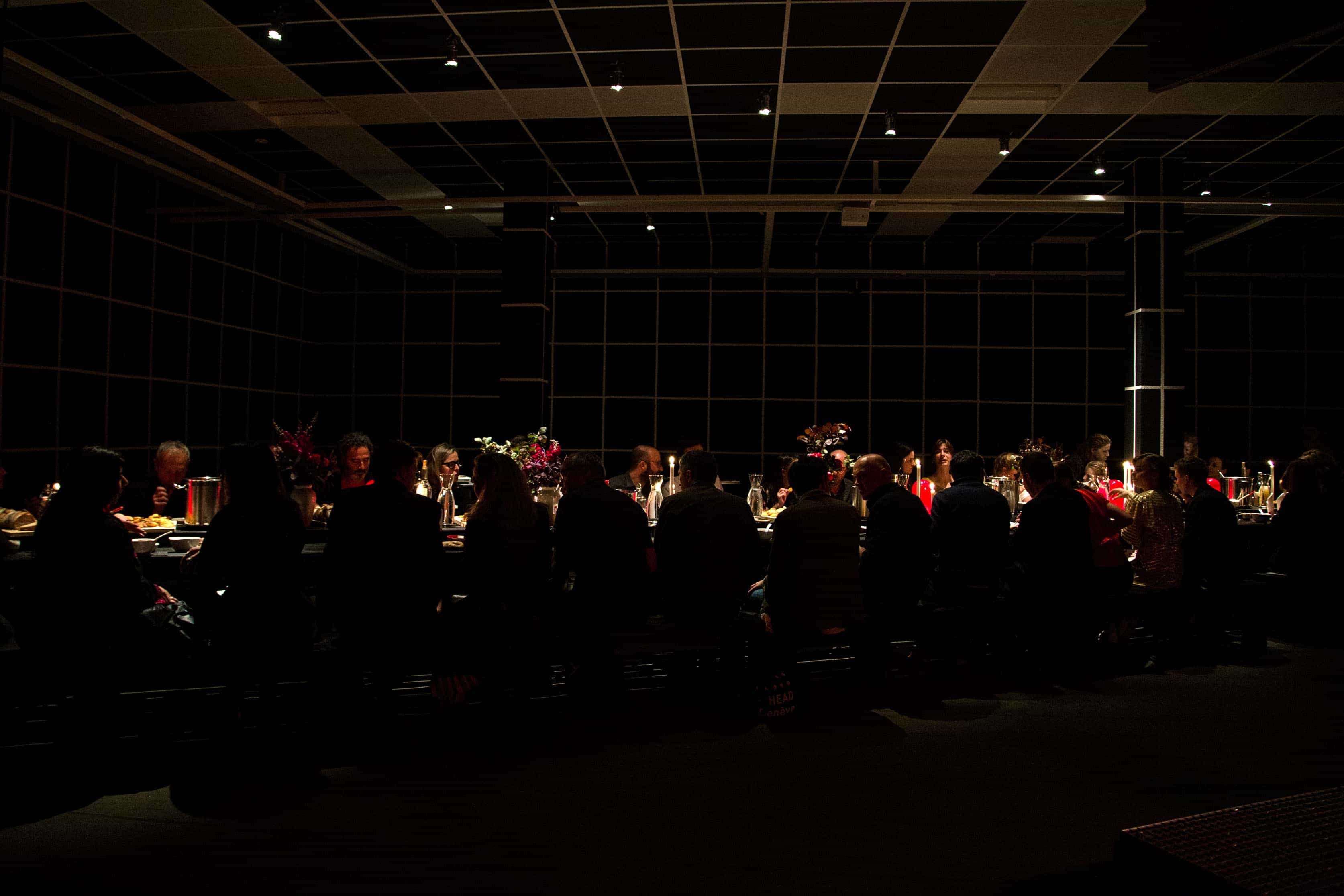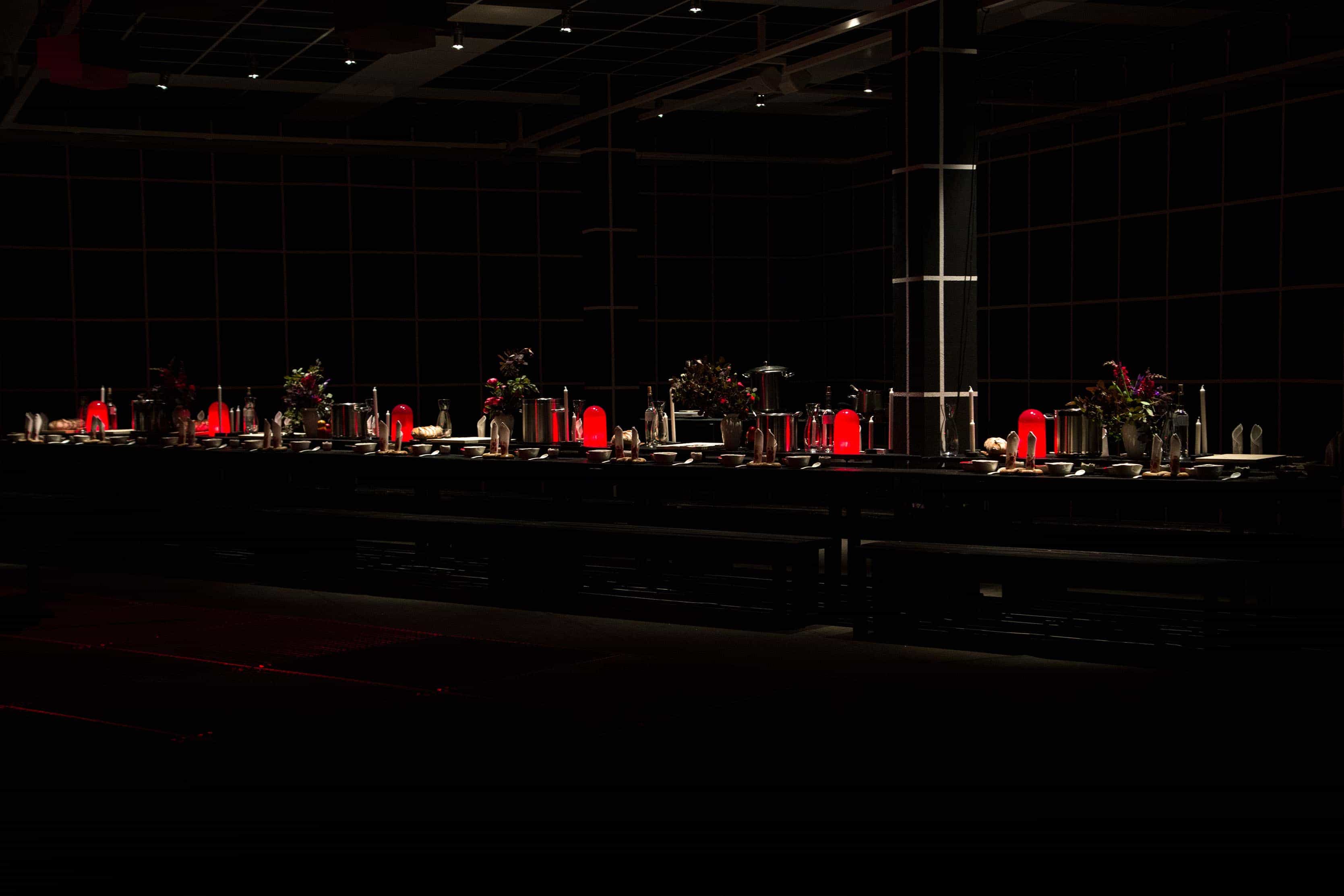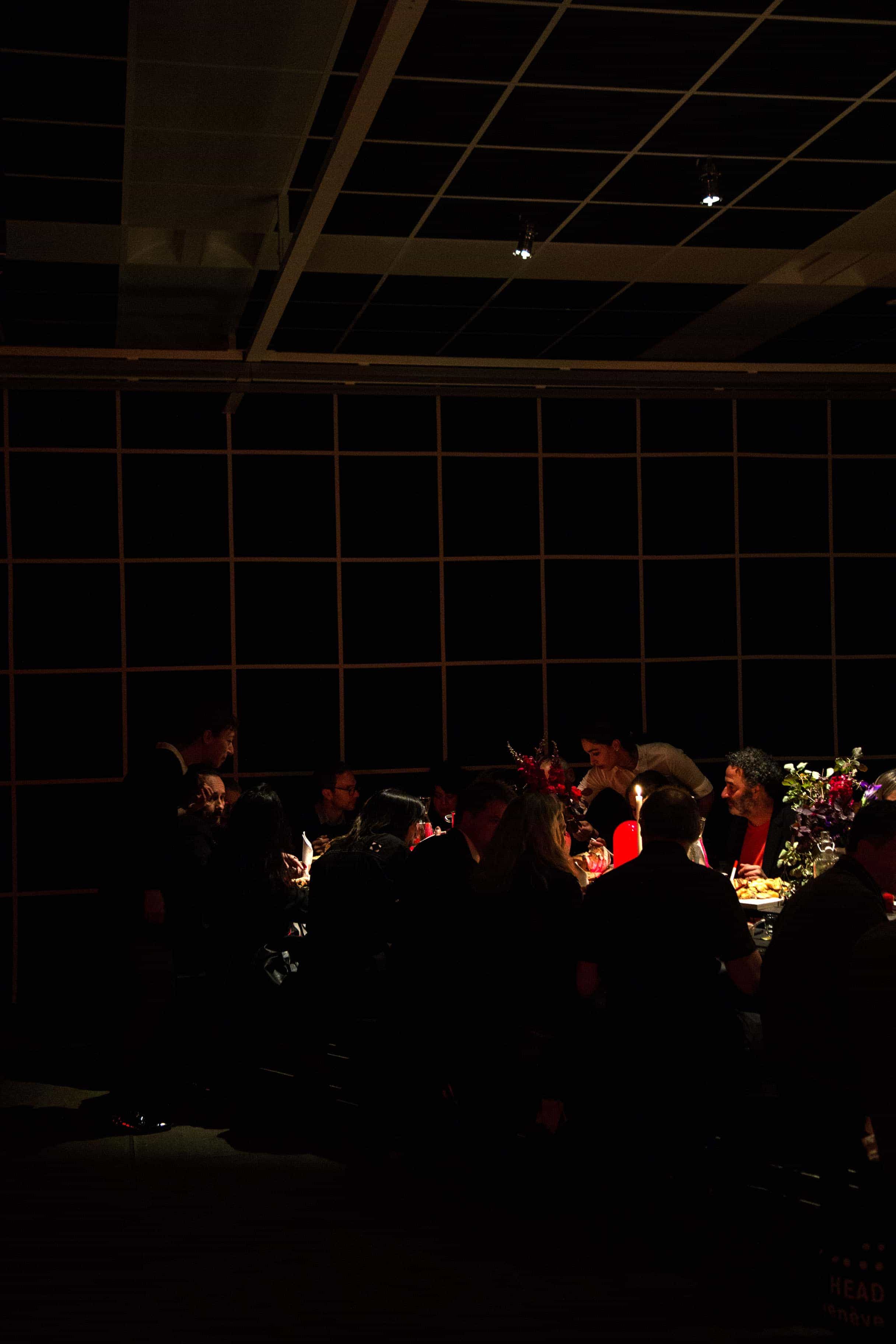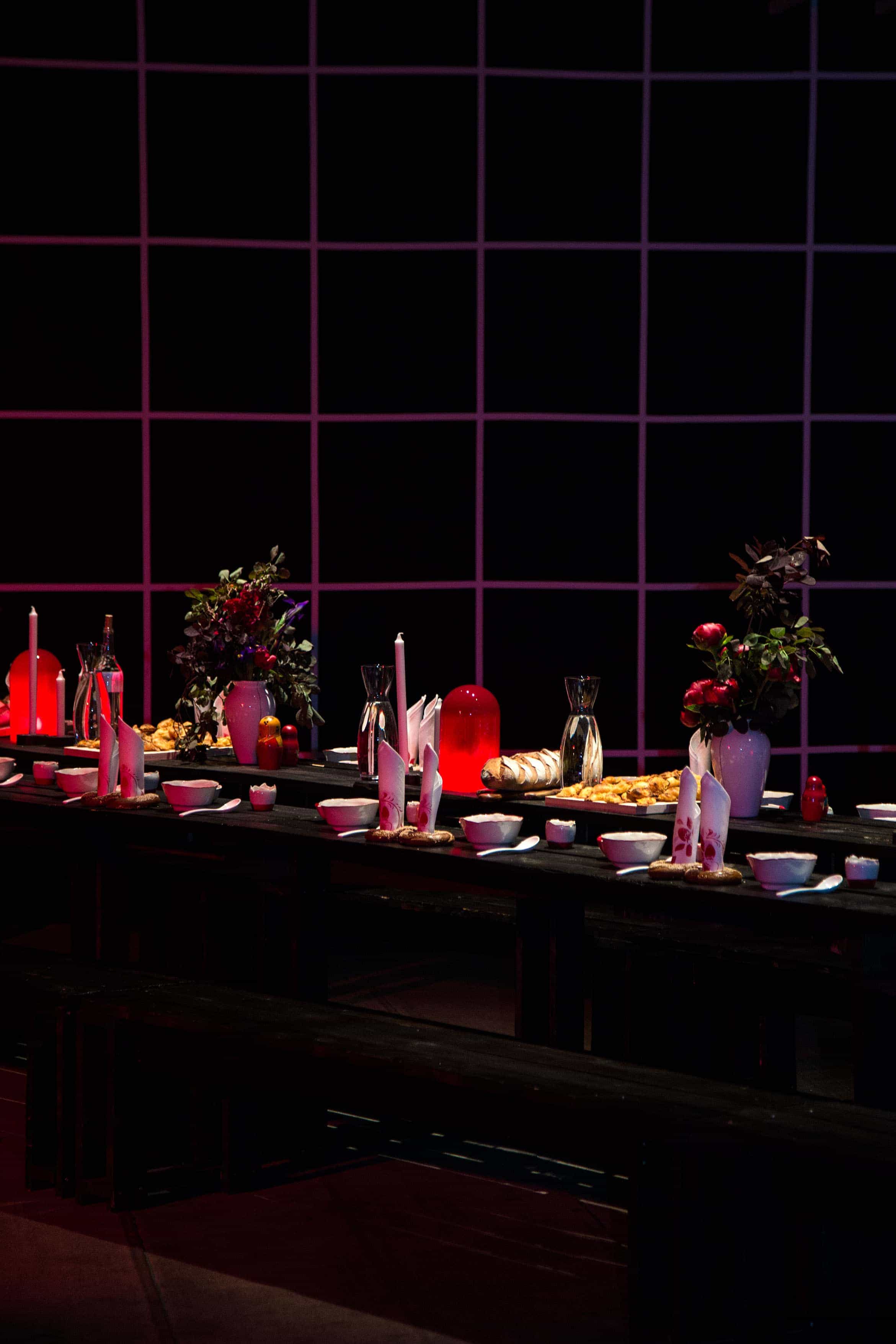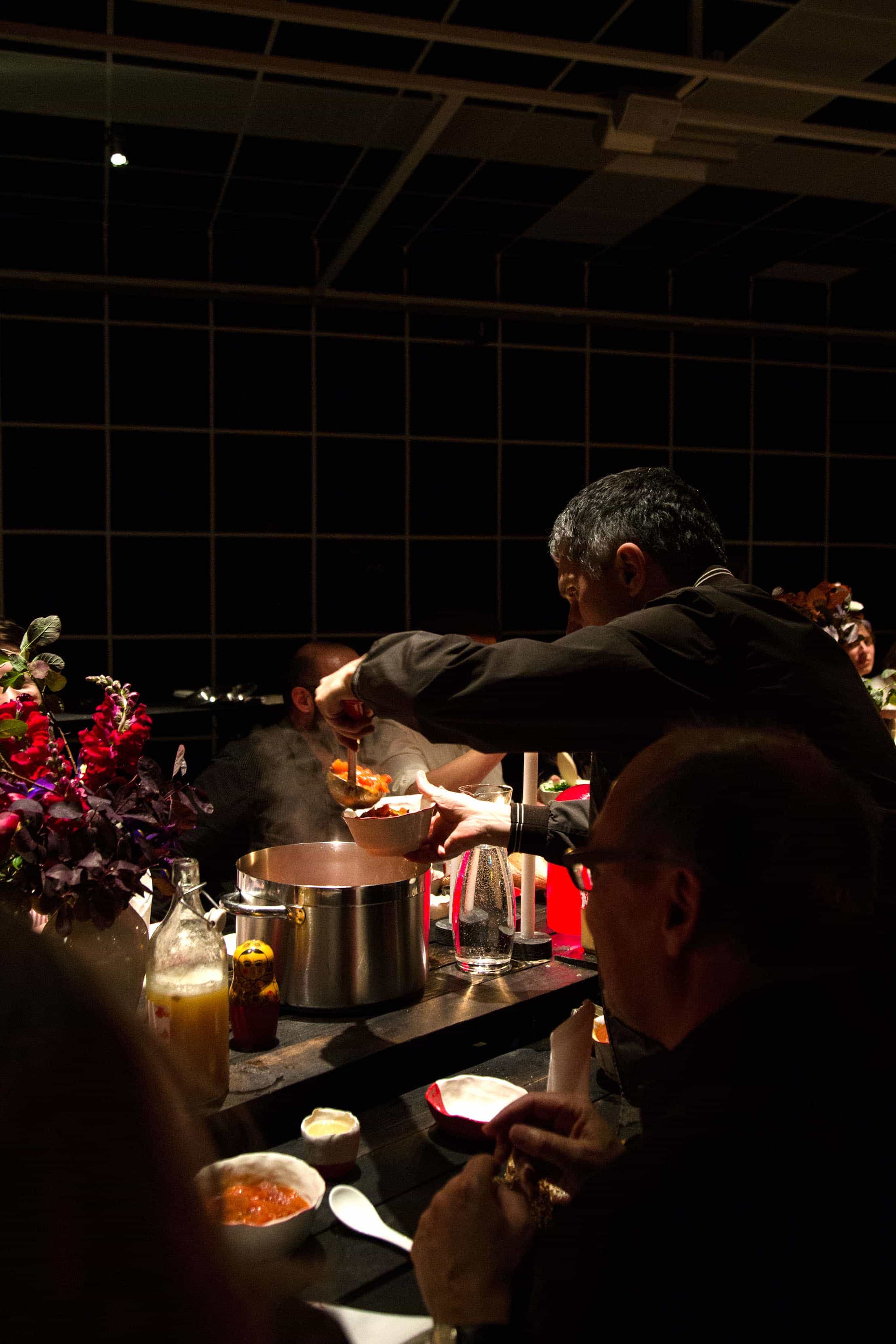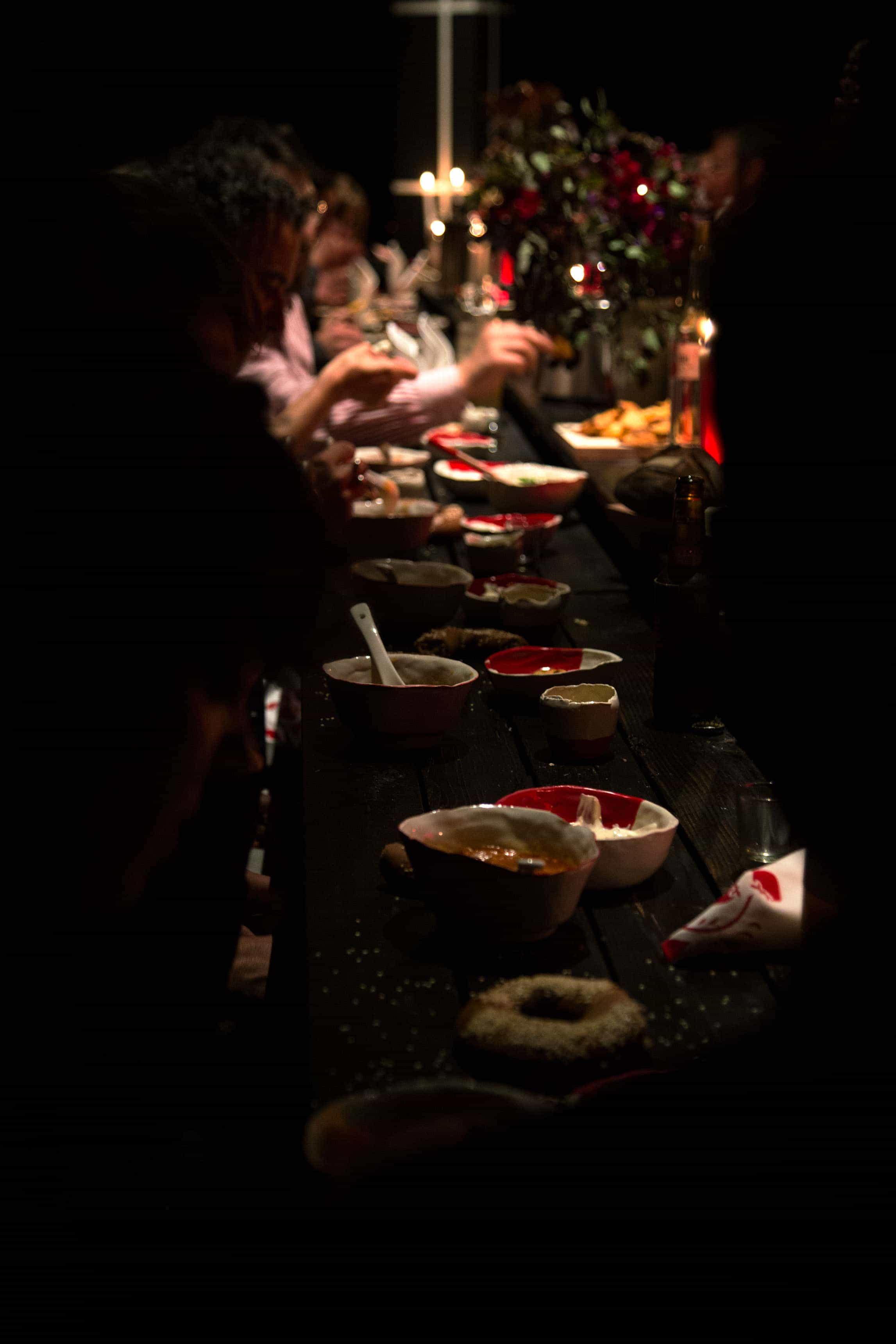A banquet installation, followed by a presentation by Julien Zanetta and a collective diner
29.05.2019, F’AR Lausanne
NIGHT FOOD belongs to a series of events from the project SCÈNES DE NUIT, that presents five nocturnal encounters exploring the role of night in the construction of contemporary cities and societies. The exhibition seeks to examine and reflect upon the spaces, activities and media unfolded in night culture, and uses evening events and ephemeral scenography as the main display platform. The scenography was developed by students of HEAD-Genève’s Bachelor in Interior Architecture.
The night is double in nature: sleep and dreams, nightmares and death, the end of one day and the promise of a new dawn. It can be a moment of solitude, peaceful or anxious, or an opportunity to get together. The banquet embodies this moment when people gather around a meal. The term comes from the Italian banchetto, the feast, which is derived from banco, the bench, thus representing a space where benches were arranged around tables to eat and converse. The FOOD exhibition focuses on the creation of a nocturnal banquet on the theme of Russia where guests share a moment around a meal with the aim of giving meaning to the action of eating together. As night falls, the space fades away, and only the table and the guests can be seen. Boundaries recede in the darkness, giving way to time, which thickens and becomes a place for conversations or silence shared among guests around the table.
Curators: Javier F. Contreras, Youri Kravtchenko
Assistant: Manon Portera
Students: Tania Bersier, Rafael Donoso, Noémi Dux, Shanna Lancian, Clora Losey
HEAD–Genève Interior Architecture Department
Photos: © Jerlyn Heinzen
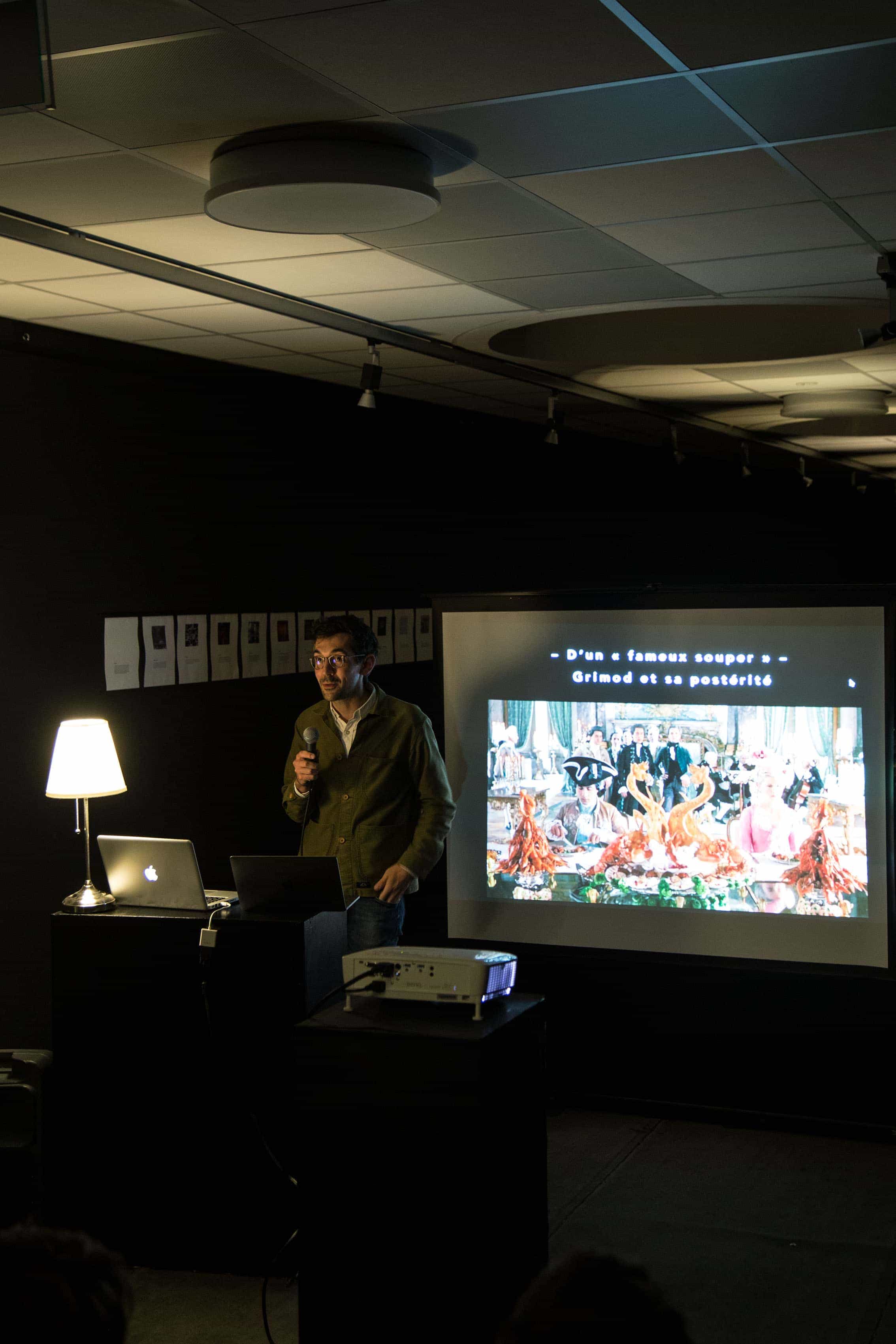
A presentation by Julien Zanetta
In this presentation, Julien Zanetta adresses the theme of meals in the 19th century. His commentary provides parallels to, as well as an in-depth study of the ritual of meals through writings in modern French and comparative literature.
Julien Zanetta Thank you, Youri, and good evening everyone. It`s a sinister task to have a hungry audience ready to jump into the next room where dinner awaits them, and the role I have tonight is maybe a little heavy, but I am going to try to make it a little lighter with the subject I have chosen. This subject came up for the good reason that Youri, one night, said to me: "Do you have something in mind about this person? " - which I am going to tell you about -, a certain Mr. Grimod de la Reynière. I am going to introduce you a little bit to a particular event, which has an importance, and I also think in a more general way, on the historical and cultural level, has been a little "overlooked".
We have a bit neglected Grimod, perhaps for good or bad reasons, but I will try to show you that these are bad reasons, because he is an important man. And it is important also in connection with what we are going to live tonight, perhaps, if I succeed! Because the challenge is there: there is a knot to be made that is quite complicated, namely the knot of the night on the one hand, and the knot of the food on the other. Add to that the historical time of the events, and it's quite difficult to get out of it! So, in order to do things and to "flatten" a conceptual terrain that can be quite dense, I referred to a historian, Mr. Alain Cabantous, who asked this question quite rightly: "Is a history of the night possible? » "Is a history of the night possible? »
According to him - and he is well informed - it is quite difficult, because, as you may have experienced in your long journey through this exhibition, it is on the one hand a particularly elusive concept, and of course it changes as time goes by. Cabantous in this case perhaps spends whole pages trying to define it in terms of time, whether it is limited according to clock time (8:00, 9:00, 10:00 in the evening...), according to religious time (around Ave Maria, or Vespers...), and these are the concrete time markers, according to astral time (before or after sunrise or sunset), or daily time (before dinner or after dinner).
In fact, this space of the night is multiform, and it is a space In fact, this space of the night is multiform, and it is a space - Cabantous says so, but others have also seen it - that is subject to control. This is a particular moment, the 18th century, which I am going to talk about, because it is a time when night lighting is increasingly beginning to have a certain presence, due on the one hand to a myth, since invalidated, that crime may reign less if it's daylight. And the more we see, the better we manage to catch, the better we manage to grasp, the better we manage to see the hidden. But it turns out that this is not true, and that a series of studies has shown that there are as many murders during the day as at night, and that in the 18th century, as in the 16th or 17th, this is a kind of constant idea.
In this case, the historians of the night came up against this first problem: a political will wanted to make day over night; you know, the gas arrived, night receded, and obviously it retreated to the provinces... the city was reigning then, and now, less and less, we know. And it also goes beyond that, in a political will, as I said, to control its citizens, but also a noticeably clear change. For example, there is an interesting fact, and a word as well, that I am going to teach you, because I learned it at the time: it is "odonymy". Odonymy is the name of the streets.
This was the name of the streets in the eighteenth century, then, we remove the night (and that's why I pronounce it that way), the name of the streets are replaced with strong political moments. The French Revolution is a rather striking example of this. Where does this lead us? It's complicated!
If I choose to speak of the night in the eighteenth century, this space that becomes more and more illuminated, more and more difficult to find in the background, which we will see with the words it manages to determine, there is also on the other side precisely the interesting part that this century plays from the "end" to the eighteenth century. Why, in the knotting that I try to operate between night and food, which was my program or at least my instruction, does the concept of taste become something completely different? There is a notion that becomes, at that moment, completely new and reinvested, that it is no longer simply a taste for the order of meaning, but it becomes a meaning that has an aesthetic faculty of judgment.
Let me explain. It goes back a long way, it goes back to Plato, to the Gorgias, where Socrates, in this dialogue, determines that taste is not an art, but a know-how. Know-how is something quite tangible, but it does not give the spectator - or those who take part in the meal - the opportunity to appreciate it as a work of art. The cook will be denied the title of artist. And this very thing is going to change at this very moment (it seems as if I am building this sort of moment of changeover, but it is actually there). Taste in the eighteenth century is obviously (I say "obviously", these are not clichés) ... it's that indeed the sensualism of Locke, Hume, Condillac, therefore the philosophers of the Enlightenment, based on empiricism - that is to say, also a concrete test of our faculties - take up Aristotle's formula saying that "nothing is in the mind that is not first of all in the senses 1 ”. "Therefore, in order for us to experience it, we will know it, we will recognize it. Therefore, in this, sensitive experience is a foundation of knowledge. And that's why this efflorescence of taste at that time adds to the panoply of the test... Obviously, painting is important, sculpture is important, experiences with that sensitive are important, and taste is a little left out, but some people come close to it, are moving towards it, trying to integrate our 5th senses which is often relegated with the sense of smell to something "insignificant", to make it possible to experiment with this sense and especially to find ways to collaborate, thus making the sight claim/reference? to taste. And so, you've understood that I'm moving gently towards a way of cooking that is as beautiful as it is good. And this thing, this way of presenting aesthetically that is as good as it tastes, has a philosophical substratum, but still, the philosopher does not consider the cook as an artist.
Except for our friend Grimod de la Reynière, who is going to start giving the profession a title, and ask of it something more, to find in the experience of dinner or eating a way to anticipate something that is going to leap forward in the 20th century, and even more so afterwards, which is performance. So, this nocturnal meal that we're having tonight, staged, has a theatrical depth. Art reigning in the 17th century, and the theater, we are going to move quickly from the theater scene to the supper, the cena, the meal, and this sort of transition from the dinner or the meal as a theatrical piece is going to be frequently evoked.
I'm just quoting this rather famous phrase (from which book?) - this edition is from 1894, but it comes before that - "The dining room is a theater, whose kitchen is the backstage and the table, the stage. In this theater, there has to be a layout; in this stage, there has to be sets; in this kitchen, there has to be a plot. »
So this machination, this way of developing the meal according to an organization has a history which is divided, by the way, between France and Russia, the French-style dinner or the Russian-style dinner are two completely opposite things. The French-style dinner will be more like an exhibition, everything is served at the same time so as to make an immediate, striking effect - I will come back later to the concept of the tableau vivant for this - while the Russian-style dinner is done, and this takes place in the middle of the 18th century, in "sequencing". In other words, it unfolds in time.
Why is this? On the one hand to eat hot, because indeed this beautiful dressing falls when the taste is no longer good. The beautiful dishes are enjoyed hot, but in fact, there, the dishes are mostly cold, because they were put there to be contemplated. Why, precisely, is the Russian service changing at all? It`s the same history of the restaurant business, it’s about providing for as many people as possible and providing them with something substantial, but good all the same: there is this division of the meal into sequences. I will come back to this later.
Here, I show you an illustration from the 18th century, quite early on. This perhaps best captures this eighteenth-century spirit, and I think you all have it in mind - excuse me, I forgot that I had put this oyster lunch on, which is an illustration that's quite funny, because there's a champagne cork that has just popped, and it catches the attention of most of the group, so it's just to show you that indeed we could gobble each other up, in a kind of great communion, with oysters in this case. But that wasn't what I had in mind. Rather, it was to tell you about Stanley Kubrick, in Barry Lyndon2 , where we have perhaps the quintessence of this 18th century spirit. Maybe that's what set me on the path to understanding the knot between night and gathering around a common object, which would be dinner.
Perhaps you all know the anecdote that Kubrick used NASA to find lenses fast enough to capture an image that was particularly dark, simply because he wanted everything naturally lit with wax candles. Imagine the logistics of the thing, which was truly hellish. He was able to find that lens, to in fact capture the meaning the candlelight gives. And that is the point I'll come back to afterwards, that sense of intimacy that, in a prevailing (throughout) the night, ties people around a table. And we see it in several instances in this film, where the meal is aesthetically served as well (we don't eat something that doesn't look like a nice dish) and so we exchange around this table, tightened, while behind the shade we gather(?).
This kind of refocusing, the condensation of attention around what we are going to ingest. And that is not indifferent. I could not resist the urge to show you a photograph of the shooting, because you can see that not only was it made for the screen, but that at the same time we participate in it cheerfully, cheerfully at heart, as you can see in the image. That's part of the game!
That's a later image, but it's also to show you that we are indeed beginning, and this is also a new thing, to appreciate the pleasure of flesh out of sin: that is to say, it's no longer simply the heavy idea of greediness, which, we'll say, hinders the only pleasure of our taste. It is a moment when, in this image, the French Revolution has gone through it, and so we can completely untie the ties between church and state and give ourselves to our hearts' content.
Let's come to the man of the evening: Alexandre Balthazar Laurent Grimod de la Reynière. Grimod de la Reynière, today, is much less well known than someone who came later, and who enjoyed a success that according to many is a little overrated, and who is Brillat-Savarin. When we say "gastronomy", we think of Brillat-Savarin, we think perhaps of Roland Barthes who wrote about Brillat-Savarin, we think of this prose which is certainly beautiful, but a little heavy, but we do not think of Grimod. Grimod is someone special: he is the son of a general farmer, which is the equivalent of our ministers today, but with a little more money. Not that they don't lack it today, no doubt, but in any case, at the time, they were plump, they were in a situation, and therefore they had a lot of money, power, and when we are like Grimod, we can invent a life for ourselves that is commensurate with our ambitions.
There's something about Grimod that will launch him: this is the episode I'm going to tell you about. But before that, it must be said that Grimod has gone down in history for a book, or at least a series of books, which is called The Almanac of Gourmets, and which is the ancestor of all food critics today. François Simon is inspired by it, and all the critics come back to Grimod saying that he is the first one who dared to take up the pen and decided to make and undo certain reputations by saying: "what we eat, it is not possible like that, it must be done according to certain standards". He calibrated a way, this relationship to food.
Grimod, I show you some examples: a "good mug", one would say, with here his business card, "rue des Champs-Élysées number 1". The author of the Almanach des gourmands, with his wig, so you can see the passage - sorry, I didn't give you the dates of Grimod, it's 1758-1837, so he is really straddling the centuries, and it's particularly interesting. Grimod at the table is also the image of a critic being represented while eating. Grimod at the table is also the image of a critic being represented while eating.
You are probably wondering what this sort of cone is next to his ear, I have an explanation: "What Grimod had invented was a large iron pipe placed to his right and ending by its opposite pole at the ear of the chef. In this way, the orders flew, and were transmitted with the speed of thought. "One sees Grimod at the table, gagging, but at the same time turning around and perhaps saying "more salt! "or I don't know what he could say to them!
This is the image of the critic properly "with his hands in the sludge". Another image, the "meditations of a gourmand", where in this representation we see the pyramid behind him with a large quantity of quality products - where the "audiences of a gourmand". We really see the staging of a character who represents himself with his pen in his hand, deciding to evaluate what he was going to be served, and no doubt refusing what was not the custom to consume.
Here is this Almanac des gourmands of Grimod de la Reynière. Let's come to our episode: Grimod is 25 years old, and decides one fine evening to have a party, but not just any party! Guests receive this: a small announcement. "You are invited to attend the dinner-collation of Me, Alexandre Balthazar Laurent Grimod de la Reynière, squire, lawyer at the Parliament, member of the Academy of the Arcades in Rome, free associate of the Museum of Paris, and editor of the dramatic part of the Journal de Neufchâtel, which will take place at his home, rue des Champs-Élysées, on the first day of February 1783.
We will do our best to receive you according to your merits, and without flattering ourselves yet that you are fully satisfied, we dare to assure you from today that on the side of oil and pig, you will have nothing to desire.
We will meet at 9:30 a.m. for dinner at 10.
You are urgently begged not to bring a dog or a valet, as the service is to be done by ad hoc servants. 3 »
What is really striking (and I regret, I did not manage to find the real invitation) is that this little invitation was on black paper, framed in black, like a mourning announcement; and in fact, it was a mourning announcement! And I'm going to bring you in little by little into this long meal.
Grimod invites people, and we have representations of them, to a special meal at night, organized according to his care. Grimod invites people, and we have representations of them, to a special meal at night, organized according to his care. This meal will be done by candlelight, and we will be seated around a catafalque (this circular decoration that supports a coffin) : it is a kind of funeral decoration. There, one would be supposed to see this Grimod, hand to the Napoleon in his puck, and followed by his assistants-cooks. All this to celebrate what? We can't really imagine how sharp the thing is with the taste we have today. We tell ourselves that it's quite simple to have a small party with friends and then to do some kind of eccentricities. It's not that at all!
Grimod made sure that each of his guests were picked up at their house. One is picked up at their place, and then taken on a tour of Paris for an hour, vague, very vague, until they forget exactly where they were. It was a conditioning to prepare each guest. It is the night, one arrives in an antechamber, dark, then in another antechamber, much more illuminated, a little dazzled, and then one is plunged back into darkness. Then the commensal, those who takes part in the meal, do not know exactly what will happen. One doesn't know what they are eating, it is food. So the blind task of this meal is that we don't know what they have eaten. The stories keep quiet about that. We are going to see a 19th century writer who invented what they ate, and maybe that gives us a vague idea of what it might have been.
The idea is to deal with an audience that is willing to eat a particular meal.The idea is to deal with an audience that is willing to eat a particular meal. Grimod, not content with this effect, sent out other invitations to much more ordinary people, to join on a gallery around the room, overlooking it, so that they could watch what the others were going to eat. So a sort of specular device, with the public being watched. And those who ate were in fact objects of a spectacle. So it actually becomes a little more complicated...
Here is one of the reviews: Restif de La Bretonne, who is a fantastic French writer who wrote Nuits de Paris, where we discover a kind of underground world of the capital by this Grimod de la Reynière, and in this second supper (because there were several), he speaks precisely about a moment afterwards when there was an imitation of the Chinese shadows: "when everyone had taken part in these different drinks, we passed into a room totally deprived of lights, in which the magic lantern was demonstrated; after which the guests withdrew."4
"when everyone had taken part in these different drinks, we passed into a room totally deprived of lights, in which the magic lantern was demonstrated; after which the guests withdrew. »
There is something deeply interesting in the very idea of a meal that lends itself to sensory experimentation in all the senses; that is, not only will we taste something we can't even recognize, it`s the famous example of "Pineapple vs. Descartes", and that would be a great title for an article! The pineapple it is a product recently discovered in the XVIIIth century, but Descartes says to us "No no no, we already have that, we would manage very well to determine of a taste", but it is so different that in fact we would not manage to determine it: it is necessary to have known it to know how to describe it then, and to determine a particular place for it in the whole of our knowledge.
Imagine these people plunged in the dark, discovering something they can't even recognize. Imagine these people plunged in the dark, discovering something they can't even recognize, and then being exposed to the public eye, and moreover with this new science of the image projected with the magic lantern! We really have something quite intriguing.
So, I'll try to go a little faster, there are several people in the nineteenth century who remembered it. It is necessary to understand why this scene struck peoples mind: this scene struck because on the one hand, there was a kind of great reputation of Grimod which was created after the first supper. There was a second one that was a little less successful. And 35 years later, even though Grimod felt weak, he had another supper, but this time with a real announcement. He invites people to his funeral, that is to say that his wife invites her friends to his funeral. Funeral that he mimes: he puts himself in a coffin in the middle of the room, and there he is while the people are next door in a chapel, then a side door opens and we discover that Grimod is not dead!
There is a kind of myth of the mourning meal, which made him become famous. And this mourning meal had to be appreciated, according to him precisely, in an aesthetic of a tableau vivant, namely that of an aesthetic of seizure. Something of a suspense. The climax arrives, and we stop at the image we are supposed to keep. Then other people will have grasped it, for another aesthetic that will be called after the aesthetics of the effect anticipating the movement of the viewer, wanting exactly the point of this aesthetic enjoyment to arrive, and becoming a kind - and I drop the word - of total work of art.
So this total work of art, the one who was perhaps the quickest to grasp it (I'll pass pardon on Daumier's image, which was just made for a vague transition between the 18th and 19th centuries, in the sense that there were also banquets then : "Gentlemen... we still have a 43rd toast to make... to the Temperance Society", to show you also that the banquet was not only there for aesthetic enjoyment at the time), it is another writer that I would like to talk to you about now and who rewrote Grimod de la Reynière's supper, and who is Joris Carl Huysmans. You may have heard of him in this book called À rebours. À rebours, 1884, is a sort of encyclopedia of Dandyism of that time. Des Esseintes, which is the name of this dandy, decided to retire from worldly life, but before retiring, made a last supper that I will read to you: "[Des Esseintes] acquired the reputation of an eccentric, which he perfected ... by giving men of letters resounding dinners, one among others, renewed from the eighteenth century, where, to celebrate the most futile of misadventures, he had organized a mourning meal.
In the dining room covered in black, opening onto the garden of his suddenly transformed house, showing its coal-powdered alleys, its small basin now bordered by a basalt curbstone and filled with ink, and its flower beds all arranged with cypresses and pines, the dinner had been brought on a black tablecloth, lined with baskets of violets and scabies, lit by candelabras where green flames burned.
While a concealed orchestra played funeral marches, the guests were served by naked negresses with mules and silver linen stockings, sown with tears.
We had eaten on plates lined with black, turtle soup, russian rye bread, ripe olives from Turkey, caviar, mullet poutargues, smoked frankfurt puddings, game with liquorice juice and wax sauce, truffle coulis, amber chocolate creams, puddings, nectarines, raisins, blackberries and jingles; drunk, in dark glasses, the wines of Limagne and Roussillon, Tenedos, Val de Peñias and Ports; enjoyed after coffee and walnut stain, kwas, porter and stout. "The dinner of a momentarily dead manhood was written on the invitation letters like those of the funerals."5
"The dinner of a momentarily dead manhood was written on the invitation letters like those of the funerals."
So there we really have the literary rewriting of Grimod's supper, but we also recognize that Huysmans determined something that history does not tell us, that is, the meal became chromatic. The chromatic meal makes us realize that the whole purpose, the expectation towards which it tends, is that kind of tenacity of the black in the food, and that this black in the food will contribute to the quintessence of the mastery of the senses. And this is what this theory of dandyism, as determined by Hyusmans, is heading towards: it is the meal of the man-god, of the one who has determined what to eat, the genius fireworksman who, in his own little world, controls his spectators.
And the one who best understood, because obviously, you say to yourself, budding artist or amateur, that this is likely to make a performance, and that someone didn't wait: it was an Emmanuel Giraud who made this performance called "Devenir gris, or memory of the funeral meal of Grimod de la Reynière", where, based on Grimod with the help of Huysmans, he made this meal, a performance in Montpellier. He relived this funeral meal with guests chosen like us tonight, in exactly the same way, for our right qualities, you said it before, and afterwards, the goal of the game was still to film their reactions. Reactions where we see for example the food historian Pascal Ory... People more or less cultured or not, in fact we don't care, it was just to experience what we ate and what we ate was not said: the menu is not given, we can discover it little by little, and then we have to be filmed. And the more you are filmed, the more you become alive, the more vague the memory of the food becomes. This performance gave rise to many others. Giraud did at the Villa Medici a stage/scene, a Trimalcion meal, he also did the Banquet which became Les Banquettes, for another performance.
In fact, this is to tell you, and I'll end here, that [ineligible] an eighteenth-century sensory element, deliberately mixing and experimenting with as many possible reactions, also wanting to derive a potential theory from it, and this is called a perennial life until Giraud gets hold of it or until others manage to make something out of it.
So, thank you very much for your attention!
Julien Zanetta, postdoctoral student involved in the research project “Bonger comprend tout ce qui est beau”, a study and critical edition of Redon-Bonger’s correspondence, studied modern French and comparative literature at the University of Geneva, where he defended a PhD dissertation in 2014 on the role of memory in Baudelaire’s art criticism. His postdoctoral research focuses on the issue of genre in painters’ biographies in 19th century France, from Stendhal to Paul Valéry. He is also interested in the work of the critic and art historian Théophile Silvestre. He has translated and edited a collection of essays on literature and aesthetics by British writer William Hazlitt. In 2010 he received the Arditi Prize for French Literature and the Hélène and Victor Barbour Prize for his Master’s thesis La mémoire et son double – Conceptions de la mémoire dans le Salon de 1846, le Salon de 1859 et le peintre de la vie moderne de Charles Baudelaire. He is the author of a book entitled Baudelaire, la mémoire des arts and of numerous publications and literary articles, and organises conferences in Geneva, Lausanne and at the Sorbonne in Paris.
- Aristotle. De Anima (Leiden & New York: E.J. Brill, 1994.) ↩
- Barry Lyndon, directed by Stanley Kubrick (1975; Burbank, CA: Warner Bros.) ↩
- Quoted vy Louis de Bachaumont, Mémoires historiques, littéraires et critiques de Bachaumont (Paris: Léopold Collin, 1808), 49. ↩
- Nicolas Restif de la Bretonne, Les Nuits de Paris, t. III, 1780, 89. ↩
- Joris-Karl Huysmans, Against the Grain (New York: Dover Books, 1969, (1884), 22. ↩
